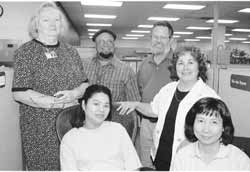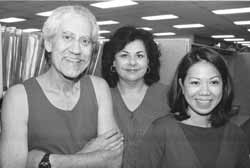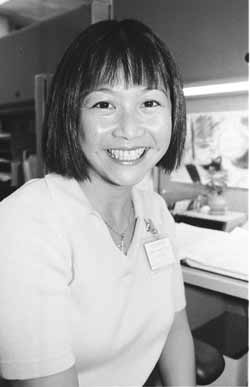|
Santa Clara
Sept-Oct 2001 As our population ages we need to expand our medical and support services for the elderly. Census data show the 85-and-older population rose 274% from 1960 to 1994, the fastest growing group among those over 65. In one recent survey, conducted for the National Partnership for Women and Families, two-thirds of women ages 40 to 59 polled said it was likely they would be responsible for the care of an elderly parent or other relative in the next 10 years. A recent study by UC Irvine estimates that by 2002 demand for home health vocational nurses will increase by 41%, and 11% for registered nurses. However, in California, the number of agencies that provide home health care services has shrunk from 1,440 to 880 in the past few years. Part of the home-health-care industry’s problems resulted from Medicare changes that were part of Clinton’s Balanced Budget Act of 1997. The act rolled back reimbursements and capped amounts per patient. In addition, there is an acute shortage of trained home care workers because too many of the state’s 220,000 home care workers make little more than minimum wage with no benefits. Though studies have shown in home support services are cheaper than long term institutionalization and preferable to seniors and members of our disabled community, the lack of affordable, accessible, quality home health care services remains a difficult problem in a society reluctant to spend the funds necessary to care for its elderly and disabled citizens. Front Lines On the front lines to locate the sparse and under-funded home care services for our expanding elderly population are IHSS social workers and eligibility workers. Robert Castillo is a social worker in Santa Clara County’s In-Home Support Services. “The goal of this program is to provide the support needed to help elderly and other disabled people maintain an independent living arrangement,” says Castillo. “If this support is not available they become at risk and in need of nursing home, hospital, or residential home care.” The support their clients need runs from domestic chore work to help getting out of bed. Frequently, IHSS clients require a combination of family care and community participation. Social workers and eligibility workers in the Santa Clara IHSS department first determine an individual’s physical limitations. They consult with doctors, other medical providers, and social workers at the San Andreas Regional Center, take into account their medical history, and translate all that information into an IHSS program that is suitable for each person. 300 Caseload
Eligibility workers like Phil Cicchi, whether by home visits, over the phone, or by mail, verify their clients’ income, resources, and property to determine their eligibility for aid. Each eligibility worker has a caseload of 300 which, says Cicchi, is too many. “300 is not doable,” says Cicchi. “We do it, but it’s very difficult to give the needed levels of service. You spend as much time as you can, but then other things back up. You have to cut corners on paperwork. I wish we had more time. It’s frustrating. 300 cases is a joke. I don’t understand why eligibility workers don’t have caseload standards. We provide valuable services.” When they can’t provide needed services to help clients stay independent and in their homes, eligibility workers refer clients to other Santa Clara agencies. “Sometimes people are forced into institutions because we can’t find them needed services, or they can’t afford to pay the home care costs, or their family can’t deal with taking care of them any longer. For some of our clients, their situations are very sad. That’s the hardest part of the job.” Contract Victory Heavy caseloads are ongoing problems at IHSS, though some help for social workers might be on the way. Last year the department, in violation of the contract, attempted to unilaterally change the standards and methods of the way cases are assigned to unit employees. The chapter filed a grievance and, in an arbitration settlement, won decreases in social workers caseloads, from 300 to 235, and the creation of a labor/management task force charged to address caseload reductions, assignments, work duties, and improvement of services for the county’s IHSS clients. Social worker Pam Ward has been in the department since 1972 and is a union representative on the task force. She sees the arbitration and the creation of the joint task force as a big improvement over the way the department has been managed in the past. “I have a very good feeling about the task force,” says Ward. “We work well together. There are dissenting opinions, but it’s done in a respectful way. I think we’re finally really accomplishing something to improve our work environment and services. “Even though 235 cases is still too high, reducing our caseloads gives us an opportunity to do the little something extra that can make a difference between staying in the home and confinement in a nursing home,” says Ward. “It’s definitely improved morale. The current management is showing a willingness to not only participate in the task force, but to stand back a little to listen and to observe. “This is an attempt by both labor and management to really achieve something and to not just move along like we have in the past. It’s been a long time coming.” Home Visits
Jan Tren is an assessment social worker. She is given new cases every month to determine eligibility and assess clients’ needs. Tren was born in Vietnam and came to the U.S. with her family when she was 12. Her focus is Santa Clara’s large Vietnamese population. “People in the county’s Vietnamese community are more likely to come forward when they know someone from their country works at IHSS. I enjoy this work. You get to meet with people, spend more time with them, and get to know them in a personal way. I feel rewarded and appreciated because you’re actually bringing help to people who need it.” On her route, Tren sees people from all economic backgrounds.
“We see people who live in mansions and are destitute. They still
need our help,” says Tren. “You have to keep an open mind and
try not to judge. The hardest part of the job is when we are too late.
A family member dies before we have a chance to help. Part of the problem
is many people don’t know about the program. The best part of the
job is visiting elderly and disabled people who, though facing life’s
difficulties, continue to have a positive outlook and are thankful for
any help we can give them. They are truly inspirational.” |
|||||||||||||



